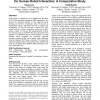Free Online Productivity Tools
i2Speak
i2Symbol
i2OCR
iTex2Img
iWeb2Print
iWeb2Shot
i2Type
iPdf2Split
iPdf2Merge
i2Bopomofo
i2Arabic
i2Style
i2Image
i2PDF
iLatex2Rtf
Sci2ools
CHI
2008
ACM
2008
ACM
Exploring the use of tangible user interfaces for human-robot interaction: a comparative study
In this paper we suggest the use of tangible user interfaces (TUIs) for human-robot interaction (HRI) applications. We discuss the potential benefits of this approach while focusing on low-level of autonomy tasks. We present an experimental robotic interaction test bed to support our investigation. We use the test bed to explore two HRIrelated task-sets: robotic navigation control and robotic posture control. We discuss the implementation of these two task-sets using an AIBOTM robot dog. Both tasks were mapped to two different robotic control interfaces: keypad interface which resembles the interaction approach currently common in HRI, and a gesture input mechanism based on Nintendo WiiTM game controllers. We discuss the interfaces implementation and conclude with a detailed user study for evaluating these different HRI techniques in the two robotic tasks-sets. ACM Classification Keywords H5.2 [Information interfaces and presentation]: User Interfaces ? Interaction Styles Author Keywo...
CHI 2008 | Human Computer Interaction | Robotic Control Interfaces | Robotic Interaction Test | Tangible User Interfaces |
| Added | 30 Nov 2009 |
| Updated | 30 Nov 2009 |
| Type | Conference |
| Year | 2008 |
| Where | CHI |
| Authors | Cheng Guo, Ehud Sharlin |
Comments (0)

